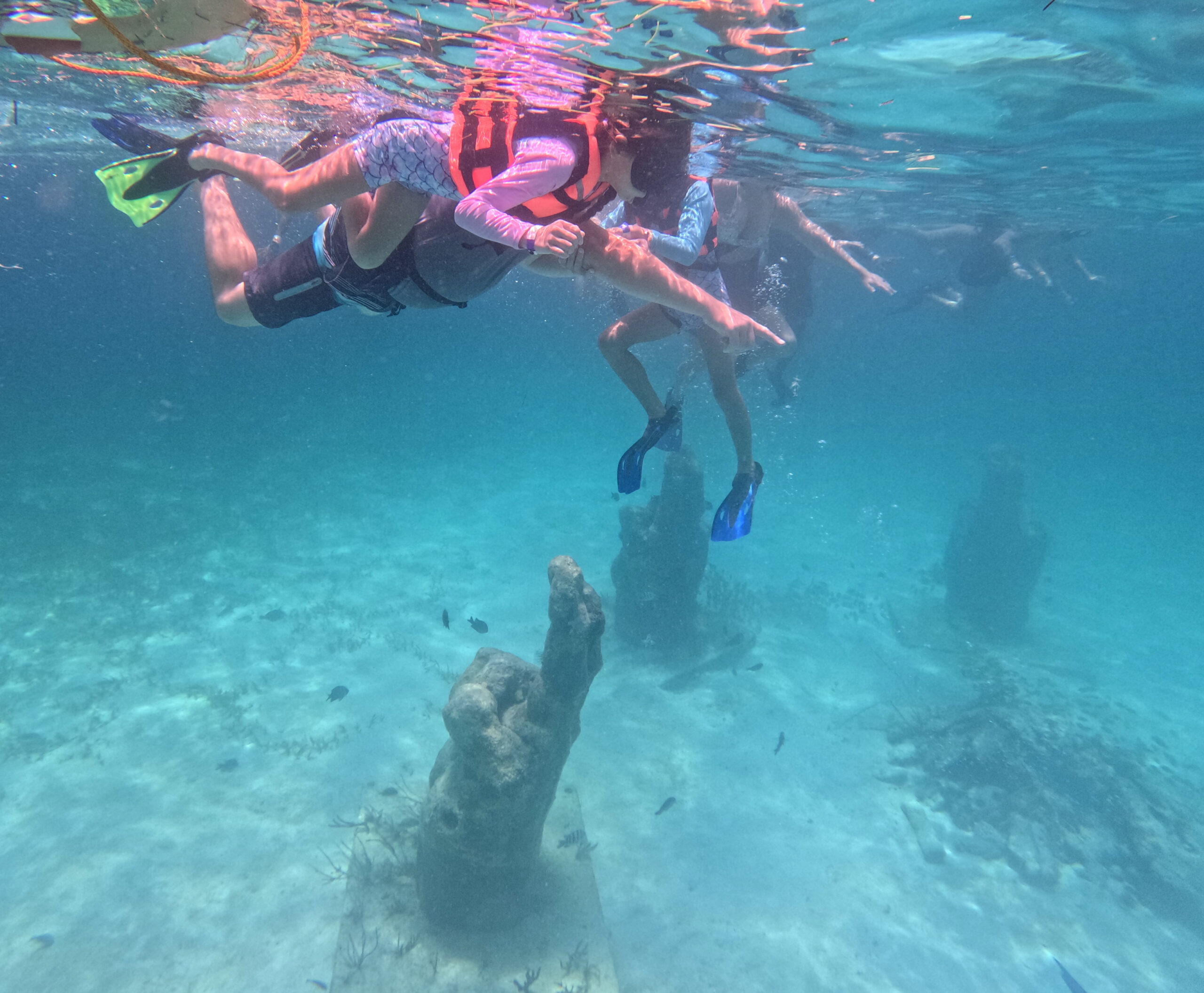If you are planning a trip to the island, this Isla Mujeres travel tips & must haves guide is for you.
Traveling safely starts long before you pack your bags. After multiple trips to Cancún and Isla Mujeres, I’ve learned that a little preparation goes a long way. These practical Isla Mujeres travel tips & must haves will serve you on any Caribbean island trip and will help you make the most of your time on Isla Mujeres or any tropical island.
What we want to achieve: Safety, confidently, comfortably and peace of mind.
Isla Mujeres Travel Safety Tips
Isla Mujeres is generally considered a safe area. At the time of this writing, it has a US State Department Travel Advisory ranking of 2 – Exercise Increased Caution. That designation is for the entire Quintana Roo area. It includes notable areas like Playa del Carmen, Puerto Morelos, Cozumel and other areas of the eastern Yucatan Peninsula.
From the US State Department website:
- A Travel Advisory is a report from the U.S. Department of State that describes the risks and recommended precautions for U.S. citizens—not foreign nationals—in a foreign destination.
- We review Travel Advisories on a regular basis.
- Levels 1 and 2: Every 12 months.
- Levels 3 and 4: At least every 6 months.
- A Travel Advisory will also be updated any time conditions change substantially. This includes when the U.S. government changes it’s staffing levels or restrictions in a country due to security concerns.
Read about Travel Advisories from the US State Department website.
I always recommend travelers enroll in the Smart Traveler Enrollment Program (STEP) if they haven’t already. It enables direct contact with the nearest US Embassy, which in this case is Cancun, provides safety and security alerts and can facilitate communication back home in the event of a crisis.
Benefits listed on the STEP registration page:
- Get updates about health, weather, safety and security for your destination.
- Plan ahead using information from the local U.S. embassy.
- Help the embassy or consulate contact you if there’s an emergency like a natural disaster, civil unrest or a family emergency.
Sign up for the STEP program here
Contact the US Embassies in Mexico here
What to Bring & What to Leave
Isla Mujeres is a 1/2 mile wide by 5 miles long silver of land in the middle of the Caribbean Ocean. It’s accessible only by boat or small aircraft and is a major tourist attraction. Needless to say, it’s salt water and sand intensive so avoid wearing expensive jewelry and protect your electronics. With that said, I have always felt safe in my personal travels around the island, but I keep a low profile and stick to day-time outings and the major throughfares.
Do Not
- Don’t bring the highly valuables from home.
- Don’t bring loads of cash or pesos.
- Don’t use rideshares or hitchhike.
- Don’t share personal details with strangers abroad: Home life, income, profession, etc.
- Don’t share detailed travel plans online.
- Don’t accept medicines, food or drinks from strangers.
- Don’t leave your passports, IDs or bags unattended.
- Don’t leave your drinks unattended.
Do
- Wear your rubberized wedding bands.
- Keep passports in a drybag when boating.
- Register for STEP.
- Share trip details with your emergency contact for visibility in the event of emergency.
- Install an offline translation app so you can communicate without cellular signals.
- Save the US consulate phone number in your phone.
- Ensure the hotel provides ATM and currency transfer services so you can take a days’ worth of cash or pesos before you go exploring.
- Install offline maps so you can navigate without cellular signals.
- Plan your tours in advance, it will typically save you money and increase your opportunity for enhanced travel awareness.
- Familiarize yourself with the route to and from the airport, port authorities, hotel, etc.
- Study the map to orient yourself with the island before you go.
- Visualize your routes with street view on google maps if possible.
- Trust your instincts while traveling abroad.
Must Haves
- Photocopies of your passport and ID in your secure cloud storage in the event your separated from your passports.
- Going out outfit.
- Geolocation tags in your luggage (Air Tags/Smart Tags).
- Spare luggage locks incase security destroys your locks.
- Reef safe sunscreen.
- Dry bag (preferably one that floats).
- Waterproof cellphone pouch for those underwater shots.
- Beach bag, backpack or both.
- Bathing suites, shorts, t-shirt (it’s hot).
- Lightweight and breathable sun protective clothing.
How to know if sunscreen is reef safe.
Know about Hawaii Reef Act compliance.
Isla Mujeres Ferry, Golf Carts & Car Rentals
Getting around Mexico can be a challenge for first time arrivals, even more so getting a car to Isla Mujeres. It is generally easier to schedule a taxi with a reputable company and have them take you to where you want to go. If you have never been before, let me be the first to tell you it’s not like driving in North America. From my perspective, it will be akin to the New Jersey Turnpike at rush hour but while driving the speed limit. For first time travelers or those who don’t know the proper Mexican driving etiquette, it’s best to leave the driving to people who live in the area.
There are several quality car and golf cart rental businesses on the island so it’s just a matter of getting there. Something I confirm for my bookings beforehand is if your hotel already offers to arrange pickup and drop-off for you or has an in-house taxi service included.
The higher end luxury resorts typically offer their own private boat to ferry you across to Isla Mujeres. It’s an amazing cruise by itself and takes approximately 20 minutes from the ports of Costa Mujeres to Isla Mujeres. This is why I recommend leaving the driving to locals and enjoying a golf cart when you need it along Isla Mujeres.
Snorkeling Safety with Kids in Isla Mujeres
DISCLAIMER — I am not a certified diver or swim instructor. These reflections and opinions are based on my personal experience. You are solely responsible for your own safety and the safety of your children while in the water.
If you’re bringing children to snorkel, it’s a good idea to teach them how to use a breathing tube in a pool or a shallow body of water beforehand and the same is true for flippers. The waves and depth of the open ocean can make it hard for a kid to get the hang of clearing the breathing tube without taking it out and trapping water in it again.
There are a few types of snorkeling masks that you can select from. I would group them into two categories: traditional masks & full faced masks. Traditional masks offer the most flexibility and performance for intermittent diving while full faced masks offer simplicity for novice users at the surface.
High quality full faced masks will:
- Not detach the breathing apparatus easily or, preferably, at all.
- Have multiple exhaust vents to keep CO2 buildup minimized.
- Will self-vent water when coming above the water line.
For the listed reasons, I recommend the Nebibo full faced snorkeling masks for children when they will not be diving though it works for that as well. Given that you will have a life jacket on at all times, diving should not be an issue. It will also be prudent to ensure the vendor allows you to bring your own gear. If you book through me, I will coordinate and confirm these details with you and the vendor before you go.
You can check out the Nebibo snorkeling headgear here
My reflections with children in Isla Mujeres, snorkeling around MUSA and reef areas:
- Before you go practice treading water.
- Before you go practice snorkeling with your child, arms locked together at the elbows.
- Learn the international recognized distress signal for boaters.
- It’s ok to just use googles by themself if that works better for your child.
- Be realistic of your child’s physical and cognitive capabilities.
- As a rule of thumb, 8 to 9 years old will be the minimum safe age for typical kids.
- Your children will need a strong adult swimmer in physical contact with them at all times.
- Stay close to the group of people while in the water as that is where the group instructor will be. The closer you are to the floating barge of people the more likely you will receive help in the event you need something.
- Be on the lookout for boat traffic and monitor your surroundings.
Learn about diver signals here
Faithful Reflection: There is only so much we can do
We strive to plan and prepare to the best of our ability. But at the end of the day, we humbly submit our plans to God and wait for Him.
The heart of man plans his way,
but the Lord establishes his steps. — Proverbs 16:9
Ready to experience this destination?
This Mamma Travels — because memories deserve a destination.

